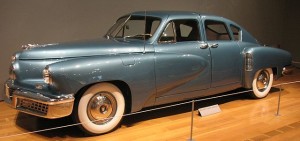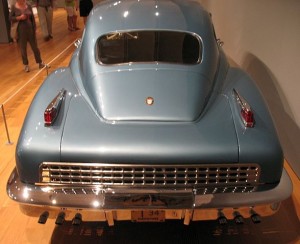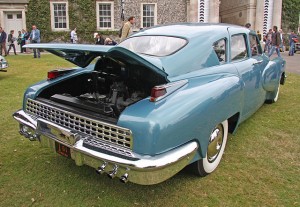Not that long ago, Torrey Blackburn ran into a former classmate who asked what he was doing these days. When Mr. Blackburn replied that he was selling wheels and hubcaps, the classmate responded incredulously, “You've been doing that forever!” Well, not forever; but you'd still be hard-pressed to find many…
The 1948 Tucker Torpedo

The 1988 movie “Tucker: The Man and His Dream“, introduced millions of people to Preston Tucker and his unusual car, the Tucker Torpedo 48. True car collectors and appreciators have always known about this 1948 “Tin Goose” a car called “ahead of its time” by many and now highly sought-after by collectors. Only 51 Tuckers were ever built, including the “Tin Goose” prototype. Amazingly, 48 of these classics still exist.
The Tucker tale is sort of a “rags to riches to rags” story. Born September 21, 1903 in Capac, Michigan, Preston Thomas Tucker spent his childhood around garages and used car lots. His first job was an office boy for Cadillac. After enrolling at Cass Technical School in Detroit, Tucker became a salesman, first for Studebaker, then Stutz, Chrysler, and finally made regional manager for Pierce-Arrow.
While a salesman, Tucker met the great engine designer Harry A. Miller. In 1935 they formed Miller-Tucker, Inc. and their first customer was a man named Henry Ford. Ford signed a contract for ten race cars to be built to race at the Indianapolis Speedway. Miller and Tucker built the Indy cars but they were not up to spec for Ford and he canceled the entire contract.
With the start of World War II, all United States automobile companies were asked to help out with the war effort. Production of new cars came to a screeching halt. As the war came to an end, Tucker saw the opportunity to launch his dream. In 1946, he formed the Tucker Corporation for the manufacturing of automobiles. Using technological skills learned in WW II, Tucker’s four door, fast back sedan design was far ahead of its time in terms of styling.
Tucker began planning his dream machine in an old Dodge plant located in Cicero, Illinois. The plant had built B29 engines during World War II, and its main building covered 93 acres. The War Assets Administration (WAA) leased Tucker the plant provided he could come up with $15 million by March 1 of the following year. Tucker said he could and in July, he moved in.
Although anxious to begin work on his prototype, Tucker needed money fast. He soon discovered that anyone who could underwrite a $15 million loan also wanted control of his company. This was not what Tucker had planned. Tucker came up with another idea and began selling dealer franchises. He soon had $6 million raised to be held in escrow until his cars were delivered. These franchises attracted the attention of the Securities and Exchange Commission (SEC), and in September of 1946 an investigation was launched.
In October, Tucker came up with another idea in hopes of raising more money. A $20 million stock issue contingent upon a completed prototype was cleared by the SEC. With money in hand to build his dream car, Tucker was about to suffer his first setback. The National Housing Agency had ordered the WAA to cancel Tucker’s lease and turn the plant over to the Lustron Corporation to build pre-fab houses.

Running out of time, Tucker continued with his plans while the battle between NHA and WAA continued until January of 1947. Franchise sales fell, stock issues were delayed, and Tucker’s reputation tarnished quickly. He was finally allowed to keep his plant, but he had made some enemies in Washington. On the good side, the WAA extended Tucker’s $15 million cash deadline to July 1.
Meanwhile, Tucker had hired a man named Alex Tremulis to design and build his car. He now had only 100 days to show his prototype to his investors. Unable to obtain enough clay for a mock-up, Tremulis and Tucker began beating out sheet metal to finish the car. The first car, completely hand-made, was nicknamed the “Tin Goose.”
The Tucker ’48 premiered June 19, 1947 in the Tucker plant before the press, photographers, dealers, distributors, stockholders and brokers. For the grand unveiling, workers substituted two 12-volt truck batteries weighing over 150 pounds which caused the car’s suspension arms to snap. Workers behind the curtains quickly made repairs to get the Tin Goose up and running. Before a crowd of 5000, the curtains parted and the Tucker automobile rolled smoothly down the ramp. The Tucker was only 60 inches high and looked even lower than that. Tremulis had extended the doors into the roofline and there was a huge interior with enough room for six large adults. Thousands of orders were placed and stock sales finally cleared on July 15th.
By the spring of 1948, Tucker had a preliminary production line set up but he was $5 million short of the needed $15 for the WAA. He began a pre-purchase plan for Tucker automobile accessories such as radios and seat covers and managed to raise another $2 million. When the SEC heard Tucker was selling accessories on cars which had not yet been built, they shook their heads. On May 28, 1948, the SEC and the Justice Department launched a full-blown investigation of Tucker Corporation. Investors soon heard and Tucker was forced to stop production of his car and let go 1600 employees. Creditors wanted their money back, bankruptcy suits began to pile up and the stock plunged. Tucker was sure that the major Detroit automakers had conspired to put him out of business. While some evidence suggested this was possible, there was no real proof. A small crew of workers assembled the only 50 cars the company would ever produce.
On June 10, 1949, Tucker and seven associates were tried for conspiracy and mail fraud. The trial opened on October 5, 1949 and the prosecution based its case on the “Tin Goose” prototype. It refused to recognize the other 50 cars. Tucker was finally acquitted in 1950, but the damage had been done. In January 1949, the plant closed and the company was put under trusteeship. The company’s holdings were auctioned off at 18 cents on the dollar and Tucker’s dream was over.

Tucker refused to let go of his goal and moved to Brazil, planning a two-seat sports car called the “Carioca.” Before he was able to pursue this last dream, Tucker died from lung cancer on December 26, 1956 at the age of 53. Out of those 51 cars produced, Tucker would be proud to know that 48 are still alive and kicking today. Few owners ever put them on the road, but most are in running condition. The majority of the cars are housed safely in museums throughout the U.S. Tucker’s dream is alive and well, living in the 20th century.
The Tucker Torpedo had a 128-inch wheelbase, a 219-inch body, and raised just 60 inches off the ground. The car featured an all-independent suspension and a rear-mounted flat-six engine inspired from a Word War II helicopter. The engine was an all-alloy motor weighing 320 pounds. The car weighed 4,200 pounds and had a top speed of 120 mph. The Tin Goose could get up and fly from 0 to 60 in about 10 seconds. Some unique features were interchangeable front and rear seats. This was to even upholstery wear. In addition to its two standard headlights, the Tucker featured a central “cyclops-eye” headlight that tracked with the front wheels. The Tucker was also the first car to utilize a fully sealed water-cooling system. Safety features included a padded dash and crash wells for both driver and passenger to drop into if a crash was about to occur. A safety glass windshield popped out upon impact. The car was quite impressive for its day. The projected price of the Tucker was $2,450.
Today a Tucker is worth anywhere from $1,000,000 on up. In January of 2012 Tucker #1043 was auctioned off at $2.65 million!







